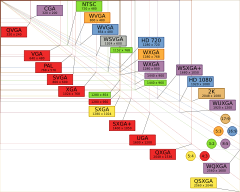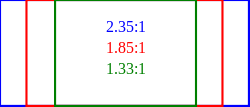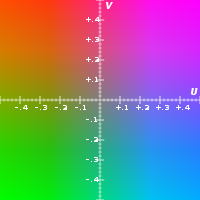- Video
-
For films or movies, see Film. For other uses, see Video (disambiguation).For the use of video in Wikipedia articles, see Wikipedia:Creation and usage of media files.
Video is the technology of electronically capturing, recording, processing, storing, transmitting, and reconstructing a sequence of still images representing scenes in motion.
Contents
- 1 History
- 2 Description of video
- 3 Characteristics of video streams
- 4 Video formats
- 5 Display devices
- 6 See also
- 7 References
- 8 External links
History
Video technology was first developed for cathode ray tube (CRT) television systems, but several new technologies for video display devices have since been invented. Charles Ginsburg led an Ampex research team developing the first practical video tape recorder (VTR). In 1951 the first video tape recorder captured live images from television cameras by converting the camera's electrical impulses and saving the information onto magnetic video tape.
Video recorders sold for $50,000 in 1956, and videotape cost $300 per one-hour reel.[1] However, prices steadily dropped over the years; in 1971, Sony began selling videocassette recorder (VCR) tapes to the public. After the invention of the DVD in 1997 and Blu-ray Disc in 2006, sales of videotape and tape equipment plummeted.
Later advances in computer technology allowed computers to capture, store, edit and transmit video clips.
Description of video
The term video (meaning "I see", from the Latin verb "videre") commonly refers to transmission and storage formats for moving pictures. Storage formats include digital video formats, including Blu-ray Disc, DVD, QuickTime (QT), and MPEG-4; and analog videotapes, including VHS and Betamax. Video can be recorded and transmitted in various physical media: in magnetic tape when recorded as PAL or NTSC electric signals by video cameras, or in MPEG-4 or DV digital media when recorded by digital cameras. Quality of video essentially depends on the capturing method and storage used. Digital television (DTV) is a relatively recent format with higher quality than earlier television formats and has become a standard for television video. (See List of digital television deployments by country.)
3D-video, digital video in three dimensions, premiered at the end of 20th century. Six or eight cameras with realtime depth measurement are typically used to capture 3D-video streams. The format of 3D-video is fixed in MPEG-4 Part 16 Animation Framework eXtension (AFX).
In many countries, the term video is often used informally to refer to both Videocassette recorders and video cassettes; the meaning is normally clear from the context.
Characteristics of video streams
Number of frames per second
Frame rate, the number of still pictures per unit of time of video, ranges from six or eight frames per second (frame/s) for old mechanical cameras to 120 or more frames per second for new professional cameras. PAL (Europe, Asia, Australia, etc.) and SECAM (France, Russia, parts of Africa etc.) standards specify 25 frame/s, while NTSC (USA, Canada, Japan, etc.) specifies 29.97 frame/s. Film is shot at the slower frame rate of 24photograms/s, which complicates slightly the process of transferring a cinematic motion picture to video. The minimum frame rate to achieve the illusion of a moving image is about fifteen frames per second.
Interlacing
Video can be interlaced or progressive. Interlacing was invented as a way to reduce flicker in early mechanical and CRT video displays without increasing the number of complete frames per second, which would have required sacrificing image detail in order to remain within the limitations of a narrow bandwidth. The horizontal scan lines of each complete frame are treated as if numbered consecutively and captured as two fields: an odd field (upper field) consisting of the odd-numbered lines and an even field (lower field) consisting of the even-numbered lines.
Analog display devices reproduce each frame in the same way, effectively doubling the frame rate as far as perceptible overall flicker is concerned. When the image capture device acquires the fields one at a time, rather than dividing up a complete frame after it is captured, the frame rate for motion is effectively doubled as well, resulting in smoother, more life-like reproduction (although with halved detail) of rapidly moving parts of the image when viewed on an interlaced CRT display, but the display of such a signal on a progressive scan device is problematic.
NTSC, PAL and SECAM are interlaced formats. Abbreviated video resolution specifications often include an i to indicate interlacing. For example, PAL video format is often specified as 576i50, where 576 indicates the total number of horizontal scan lines, i indicates interlacing, and 50 indicates 50 fields (half-frames) per second.
In progressive scan systems, each refresh period updates all of the scan lines of each frame in sequence. When displaying a natively progressive broadcast or recorded signal, the result is optimum spatial resolution of both the stationary and moving parts of the image. When displaying a natively interlaced signal, however, overall spatial resolution will be degraded by simple line doubling and artifacts such as flickering or "comb" effects in moving parts of the image will be seen unless special signal processing is applied to eliminate them. A procedure known as deinterlacing can be used to optimize the display of an interlaced video signal from an analog, DVD or satellite source on a progressive scan device such as an LCD Television, digital video projector or plasma panel. Deinterlacing cannot, however, produce video quality that is equivalent to true progressive scan source material.
Display resolution
Main article: Display resolutionThe size of a video image is measured in pixels for digital video, or horizontal scan lines and vertical lines of resolution for analog video. In the digital domain (e.g. DVD) standard-definition television (SDTV) is specified as 720/704/640×480i60 for NTSC and 768/720×576i50 for PAL or SECAM resolution. However in the analog domain, the number of visible scanlines remains constant (486 NTSC/576 PAL) while the horizontal measurement varies with the quality of the signal: approximately 320 pixels per scanline for VCR quality, 400 pixels for TV broadcasts, and 720 pixels for DVD sources. Aspect ratio is preserved because of non-square "pixels".
New high-definition televisions (HDTV) are capable of resolutions up to 1920×1080p60, i.e. 1920 pixels per scan line by 1080 scan lines, progressive, at 60 frames per second.
Video resolution for 3D-video is measured in voxels (volume picture element, representing a value in three dimensional space). For example 512×512×512 voxels resolution, now used for simple 3D-video, can be displayed even on some PDAs.
Aspect ratio
Aspect ratio describes the dimensions of video screens and video picture elements. All popular video formats are rectilinear, and so can be described by a ratio between width and height. The screen aspect ratio of a traditional television screen is 4:3, or about 1.33:1. High definition televisions use an aspect ratio of 16:9, or about 1.78:1. The aspect ratio of a full 35 mm film frame with soundtrack (also known as the Academy ratio) is 1.375:1.
Ratios where the height is taller than the width are uncommon in general everyday use, but do have application in computer systems where the screen may be better suited for a vertical layout. The most common tall aspect ratio of 3:4 is referred to as portrait mode and is created by physically rotating the display device 90 degrees from the normal position. Other tall aspect ratios such as 9:16 are technically possible but rarely used. (For a more detailed discussion of this topic please refer to the page orientation article.)
Pixels on computer monitors are usually square, but pixels used in digital video often have non-square aspect ratios, such as those used in the PAL and NTSC variants of the CCIR 601 digital video standard, and the corresponding anamorphic widescreen formats. Therefore, an NTSC DV image which is 720 pixels by 480 pixels is displayed with the aspect ratio of 4:3 (which is the traditional television standard) if the pixels are thin and displayed with the aspect ratio of 16:9 (which is the anamorphic widescreen format) if the pixels are fat.
Color space and bits per pixel
Color model name describes the video color representation. YIQ was used in NTSC television. It corresponds closely to the YUV scheme used in NTSC and PAL television and the YDbDr scheme used by SECAM television.
The number of distinct colors that can be represented by a pixel depends on the number of bits per pixel (bpp). A common way to reduce the number of bits per pixel in digital video is by chroma subsampling (e.g. 4:4:4, 4:2:2, 4:2:0/4:1:1).
Video quality
Video quality can be measured with formal metrics like PSNR or with subjective video quality using expert observation.
The subjective video quality of a video processing system may be evaluated as follows:
- Choose the video sequences (the SRC) to use for testing.
- Choose the settings of the system to evaluate (the HRC).
- Choose a test method for how to present video sequences to experts and to collect their ratings.
- Invite a sufficient number of experts, preferably not fewer than 15.
- Carry out testing.
- Calculate the average marks for each HRC based on the experts' ratings.
Many subjective video quality methods are described in the ITU-T recommendation BT.500. One of the standardized method is the Double Stimulus Impairment Scale (DSIS). In DSIS, each expert views an unimpaired reference video followed by an impaired version of the same video. The expert then rates the impaired video using a scale ranging from "impairments are imperceptible" to "impairments are very annoying".
Video compression method (digital only)
Main article: Video compressionA wide variety of methods are used to compress video streams. Video data contains spatial and temporal redundancy, making uncompressed video streams extremely inefficient. Broadly speaking, spatial redundancy is reduced by registering differences between parts of a single frame; this task is known as intraframe compression and is closely related to image compression. Likewise, temporal redundancy can be reduced by registering differences between frames; this task is known as interframe compression, including motion compensation and other techniques. The most common modern standards are MPEG-2, used for DVD, Blu-ray and satellite television, and MPEG-4, used for AVCHD, Mobile phones (3GP) and Internet.
Bit rate (digital only)
Bit rate is a measure of the rate of information content in a video stream. It is quantified using the bit per second (bit/s or bps) unit or Megabits per second (Mbit/s). A higher bit rate allows better video quality. For example VideoCD, with a bit rate of about 1 Mbit/s, is lower quality than DVD, with maximum bit rate of 10.08 Mbit/s for video. HD (High Definition Digital Video and TV) has a still higher quality, with a bit rate of about 20 Mbit/s.
Variable bit rate (VBR) is a strategy to maximize the visual video quality and minimize the bit rate. On fast motion scenes, a variable bit rate uses more bits than it does on slow motion scenes of similar duration yet achieves a consistent visual quality. For real-time and non-buffered video streaming when the available bandwidth is fixed, e.g. in videoconferencing delivered on channels of fixed bandwidth, a constant bit rate (CBR) must be used.
Stereoscopic
Stereoscopic video can be created using several different methods:
- two channels — a right channel for the right eye and a left channel for the left eye. Both channels may be viewed simultaneously by using light-polarizing filters 90 degrees off-axis from each other on two video projectors. These separately polarized channels are viewed wearing eyeglasses with matching polarization filters.
- one channel with two overlaid color coded layers. This left and right layer technique is occasionally used for network broadcast, or recent "anaglyph" releases of 3D movies on DVD. Simple Red/Cyan plastic glasses provide the means to view the images discretely to form a stereoscopic view of the content.
- One channel with alternating left/right frames for each eye, using LCD shutter glasses which read the frame sync from the VGA Display Data Channel to alternately cover each eye, so the appropriate eye sees the correct frame. This method is most common in computer virtual reality applications such as in a Cave Automatic Virtual Environment, but reduces the effective video framerate to one-half of normal (for example, from 120 Hz to 60 Hz).
Blu-ray Discs greatly improve the sharpness and detail of the two-color 3D effect in color coded stereo programs. See articles Stereoscopy and 3-D film.
Video formats
There are different layers of video transmission and storage, each with its own set of formats to choose from.
For transmission, there is a physical connector and signal protocol ("video connection standard" below). A given physical link can carry certain "display standards" which specify a particular refresh rate, display resolution, and color space.
Many analog and digital recording formats are in use, and digital video clips can also be stored on a computer file system as files which have their own formats. In addition to the physical format used by the data storage device or transmission medium, the stream of ones and zeros that is sent must be in a particular digital "video encoding", of which a number are available.
Video connectors, cables, and signal standards
- See List of video connectors for information about physical connectors and related signal standards.
Video display standards
Further information: Display technologyDigital television
Further information: Broadcast television systemsNew formats for digital television broadcasts use the MPEG-2 video codec and include:
- ATSC - USA, Canada, Korea
- Digital Video Broadcasting (DVB) - Europe
- ISDB - Japan
- Digital Multimedia Broadcasting (DMB) - Korea
Analog television
Further information: Broadcast television systemsAnalog television broadcast standards include:
- FCS - USA, Russia; obsolete
- MAC - Europe; obsolete
- MUSE - Japan
- NTSC - USA, Canada, Japan
- PAL - Europe, Asia, Oceania
- RS-343 (military)
- SECAM - France, Former Soviet Union, Central Africa
An analog video format consists of more information than the visible content of the frame. Preceding and following the image are lines and pixels containing synchronization information or a time delay. This surrounding margin is known as a blanking interval or blanking region; the horizontal and vertical front porch and back porch are the building blocks of the blanking interval.
Many countries are planning a digital switchover soon.
Computer displays
See Computer display standard for a list of standards used for computer monitors and comparison with those used for television.
Recording formats before video tape
Analog tape formats
- 1" Type B video tape (Robert Bosch GmbH)
- 1" Type C videotape (Ampex,Marconi and Sony)
- 2" Quadruplex videotape (Ampex)
- 2" Helical Scan Videotape (Rank Cintel)
- Betacam (Sony)
- Betacam SP (Sony)
- Betamax (Sony)
- S-VHS (JVC) (1987)
- W-VHS (JVC) (1994)
- U-matic 3/4" (Sony)
- VCR, VCR-LP, SVR
- VERA (BBC experimental format ca. 1958)
- VHS (JVC)
- VHS-C (JVC)
- Video 2000 (Philips)
(See List of video recording formats.)
Digital tape formats
- Betacam IMX (Sony)
- D-VHS (JVC)
- D-Theater
- D1 (Sony)
- D2 (Sony)
- D3
- D5 HD
- Digital-S D9 (JVC)
- Digital Betacam (Sony)
- Digital8 (Sony)
- DV
- HDV
- ProHD (JVC)
- MicroMV
- MiniDV
Optical disc storage formats
- Blu-ray Disc (Sony)
- China Blue High-definition Disc (CBHD)
- DVD (was Super Density Disc, DVD Forum)
- Professional Disc
- Universal Media Disc (UMD) (Sony)
Discontinued
- Enhanced Versatile Disc (EVD, Chinese government-sponsored)
- HD DVD (NEC and Toshiba)
- HD-VMD
- Laserdisc (old, MCA and Philips)
Digital encoding formats
- CCIR 601 (ITU-T)
- H.261 (ITU-T)
- H.263 (ITU-T)
- H.264/MPEG-4 AVC (ITU-T + ISO)
- M-JPEG (ISO)
- MPEG-1 (ISO)
- MPEG-2 (ITU-T + ISO)
- MPEG-4 (ISO)
- Ogg-Theora
- VC-1 (SMPTE)
-
See also: Video codec and list of codecs
Standards
- System M
- System B
Video storage formats Videotape Quadruplex (1956) · VERA (1958) · Sony 2 inch helical VTR (1961) · Ampex 2 inch helical VTR (1962) · Type A (1965) · CV-2000 (1965) · Akai (1967) · U-matic (1969) · EIAJ-1 (1969) · Cartrivision (1972) · Philips VCR (1972) · V-Cord (1974) · VX (1974) · Betamax (1975) · IVC (1975) · Type B (1976) · Type C (1976) · VHS (1976) · VK (1977) · SVR (1979) · Video 2000 (1980) · CVC (1980) · VHS-C (1982) · M (1982) · Betacam (1982) · Video8 (1985) · MII (1986) · S-VHS (1987) · S-VHS-C (1987) · Hi8 (1989) ·
D1 (1986) · D2 (1988) · D3 (1991) · DCT (1992) · Digital Betacam (1993) · D5 (1994) · Digital-S (D9) (1995) · Betacam SX (1996) · Digital8 (1999) · MicroMV (2001) ·
High DefinitionVideodisc AnalogDigitalHigh DefinitionMUSE Hi-Vision LD (1994) · HD DVD (2006) · Blu-ray Disc (2006) · HVD (Holographic Versatile Disc) (2007) · CBHD (2008)
Digital Media agnosticTapelessVideo recorded to film Kinescope (1947) · Electronicam kinescope (1950s) · Electronic Video Recording (1967)
Display devices
Display devices for showing videos are generally full-area (rather than segmented display), sometimes simply called video displays.
See also
- General
- Audio
- List of video topics
- Video clips
- Video editing
- Video format
- Video usage
- Closed-circuit television
- Fulldome video
- Optical feedback
- Video art
- Interactive video
- Video production
- Video projector
- Video synthesizer
- Video teleconference
- Video communication
- Video screen recording
- Projects
- Redesign project
References
External links
Categories:- Video
- Digital television
- Film and video technology
- High-definition television
- Video formats
- Display technology
- Television terminology
- Video signal
- History of television
Wikimedia Foundation. 2010.




